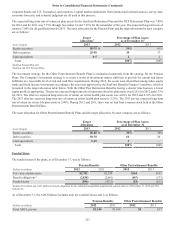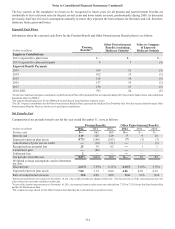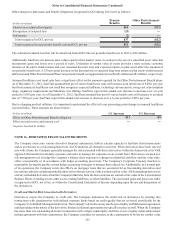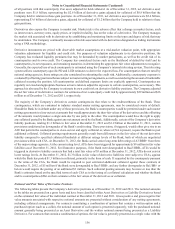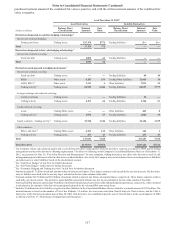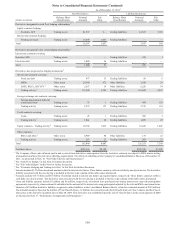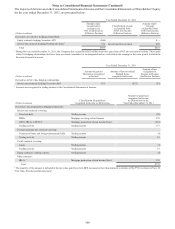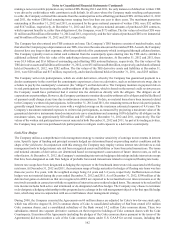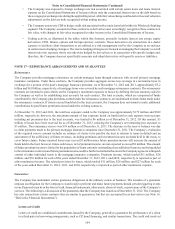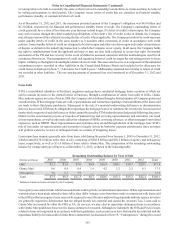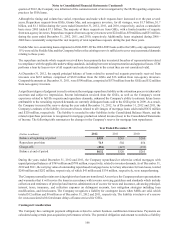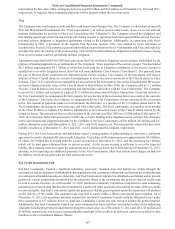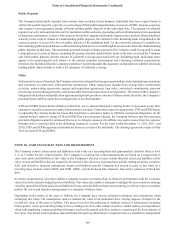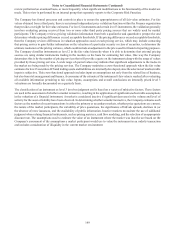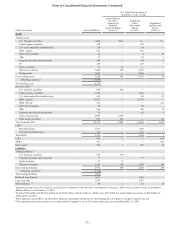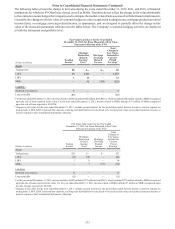SunTrust 2012 Annual Report Download - page 179
Download and view the complete annual report
Please find page 179 of the 2012 SunTrust annual report below. You can navigate through the pages in the report by either clicking on the pages listed below, or by using the keyword search tool below to find specific information within the annual report.
Notes to Consolidated Financial Statements (Continued)
163
ownership of the common shares was not legally transferred to the Coke Counterparty. The Agreements were zero-cost equity
collars at inception, which caused the Agreements to be derivatives in their entirety. The Company designated the Agreements
as cash flow hedges of the Company's probable forecasted sales of its Coke common shares, which were expected to occur
between 6.5 years and 7 years from the Agreements' effective date. The risk management objective was to hedge the cash
flows on the forecasted sales of the Coke common shares at market values equal to or above the call strike price and equal to
or below the put strike price. Since the execution of the Agreements, the Company assessed hedge effectiveness on a quarterly
basis and measured hedge ineffectiveness with the effective portion of the changes in fair value of the Agreements recognized
in AOCI and any ineffective portions recognized in trading income. None of the components of the Agreements' fair values
were excluded from the Company's assessments of hedge effectiveness. Ineffectiveness gains on the Agreements were
recognized in trading income and related to changes in market dividends. The Company recognized ineffectiveness gains of
$1 million and $2 million during the years ended December 31, 2012 and 2011, respectively.
During 2012, the Company and the Coke Counterparty accelerated the termination of the Agreements, and the Company sold
in the market or to the Coke Counterparty 59 million of its 60 million shares of Coke and contributed the remaining 1 million
shares to the SunTrust Foundation for a net gain of $1.9 billion, which is net of a $305 million loss related to the derivative
contract termination of the Agreements. Upon approval by the Board to terminate the Agreements and sell and donate the
Coke shares, the Agreements no longer qualified as cash flow hedges. Thus, subsequent changes in value of the Agreements
until termination totaled $60 million and were recognized in net securities gains in the Consolidated Statements of Income.
Amounts recognized in AOCI in the Consolidated Statements of Shareholders' Equity during the period the Agreements
qualified as cash flow hedges totaled $365 million in losses. These amounts remained in AOCI until the sale of the Coke
shares, at which time, the amounts were reclassified to net securities gains in the Consolidated Statements of Income.
Fair Value Hedges
During 2011, the Company entered into interest rate swap agreements, as part of the Company’s risk management objectives
for hedging its exposure to changes in fair value due to changes in interest rates. These hedging arrangements converted
Company-issued fixed rate senior long-term debt to floating rates. Consistent with this objective, the Company reflects the
accrued contractual interest on the hedged item and the related swaps as part of current period interest. There were no
components of derivative gains or losses excluded in the Company’s assessment of hedge effectiveness related to the fair
value hedges.
Economic Hedging and Trading Activities
In addition to designated hedging relationships, the Company also enters into derivatives as an end user as a risk management
tool to economically hedge risks associated with certain non-derivative and derivative instruments, along with entering into
derivatives in a trading capacity with its clients.
The primary risks that the Company economically hedges are interest rate risk, foreign exchange risk, and credit risk. Economic
hedging objectives are accomplished by entering into offsetting derivatives either on an individual basis, or collectively on a
macro basis, and generally accomplish the Company’s goal of mitigating the targeted risk. To the extent that specific derivatives
are associated with specific hedged items, the notional amounts, fair values, and gains/(losses) on the derivatives are illustrated
in the tables in this footnote.
• The Company utilizes interest rate derivatives to mitigate exposures from various instruments.
The Company is subject to interest rate risk on its fixed rate debt. As market interest rates move, the fair
value of the Company’s debt is affected. To protect against this risk on certain debt issuances that the
Company has elected to carry at fair value, the Company has entered into pay variable-receive fixed
interest rate swaps that decrease in value in a rising rate environment and increase in value in a declining
rate environment.
The Company is exposed to risk on the returns of certain of its brokered deposits that are carried at fair
value. To hedge against this risk, the Company has entered into interest rate derivatives that mirror the
risk profile of the returns on these instruments.
The Company is exposed to interest rate risk associated with MSRs, which the Company hedges with a
combination of mortgage and interest rate derivatives, including forward and option contracts, futures,
and forward rate agreements.
The Company enters into mortgage and interest rate derivatives, including forward contracts, futures, and
option contracts to mitigate interest rate risk associated with IRLCs and mortgage LHFS.


